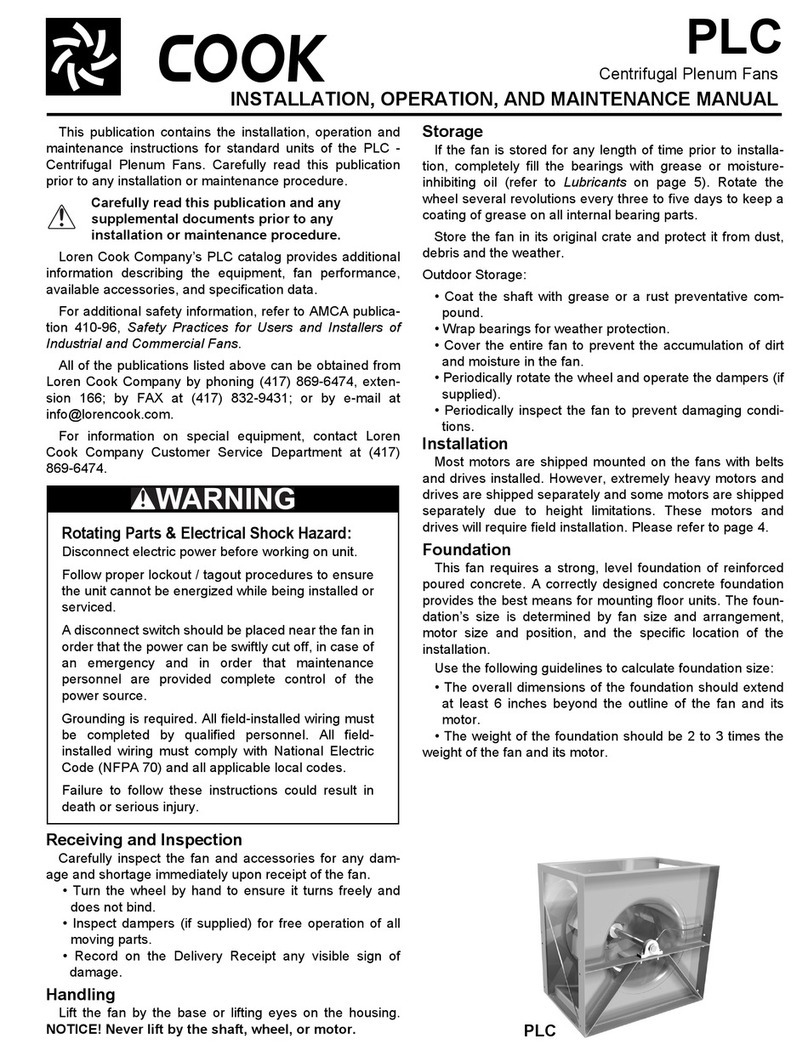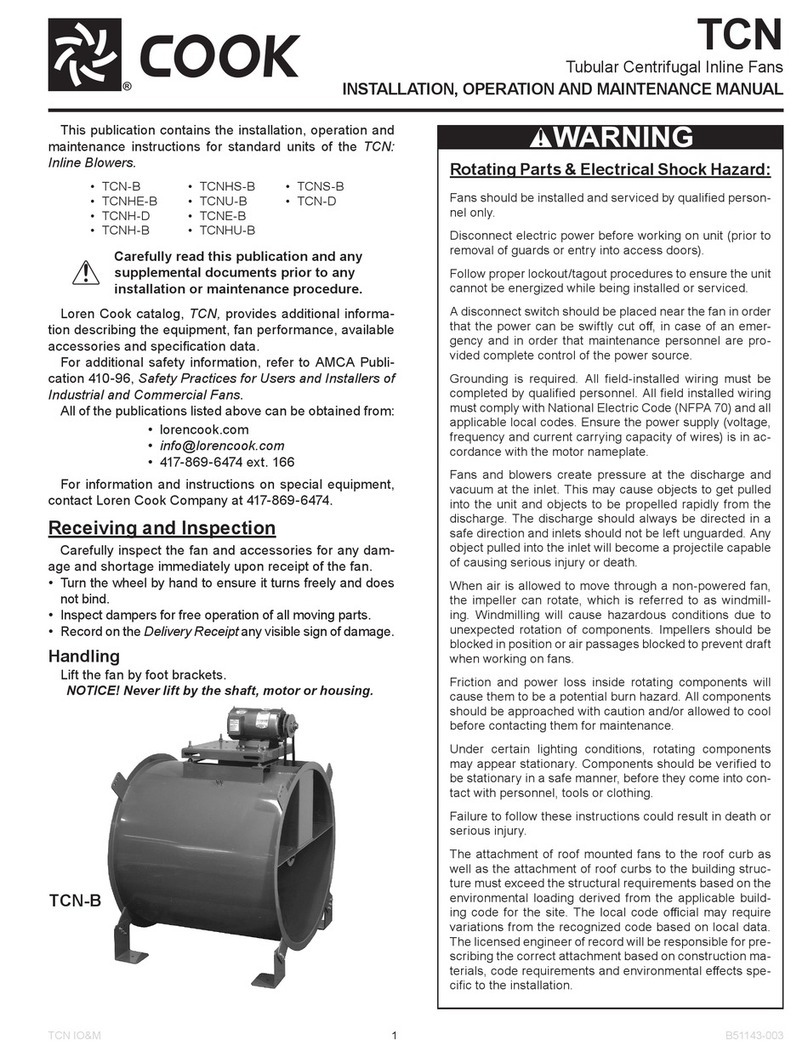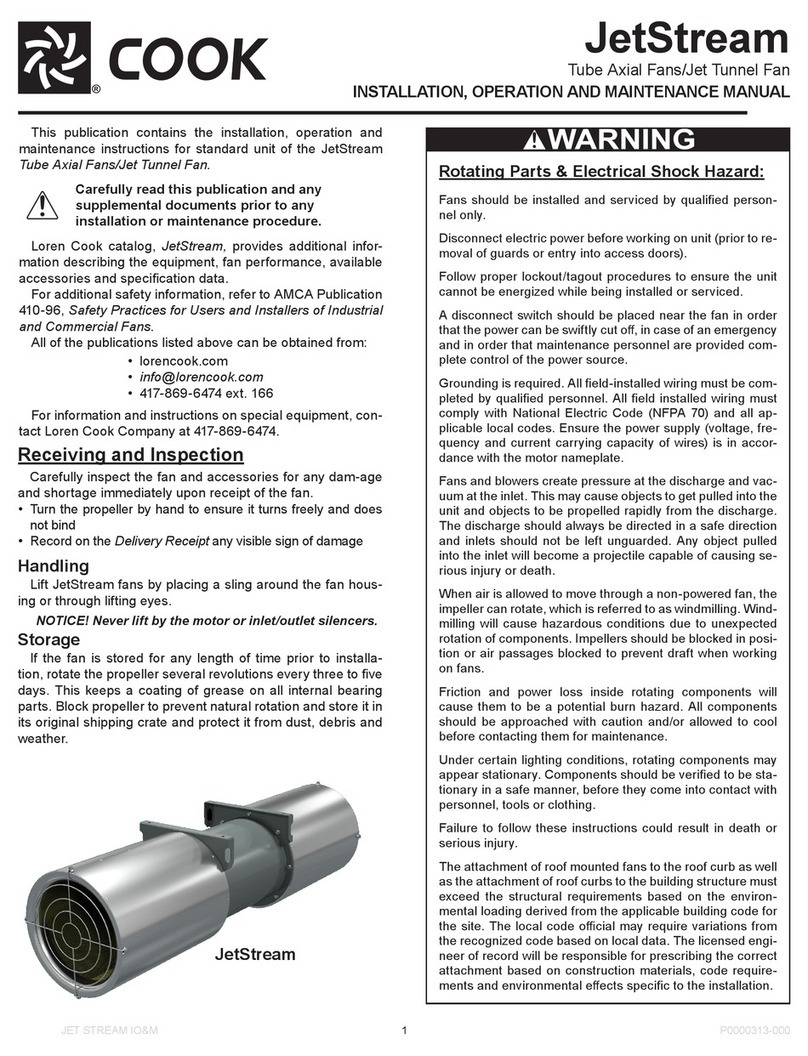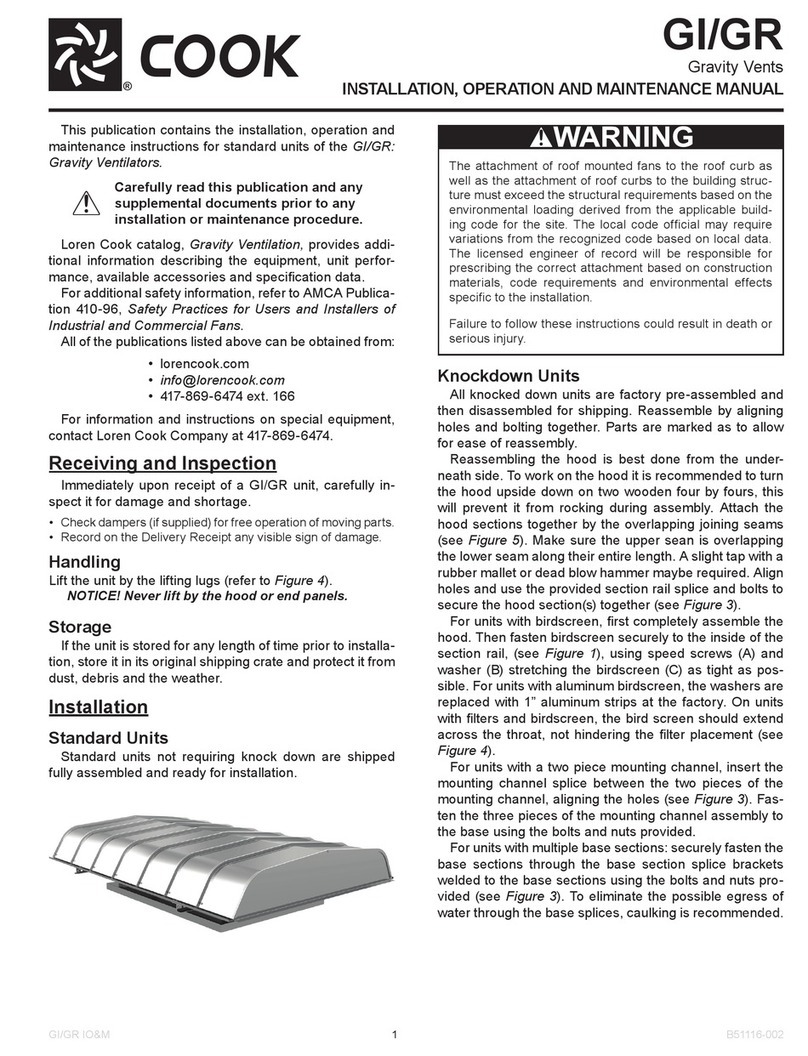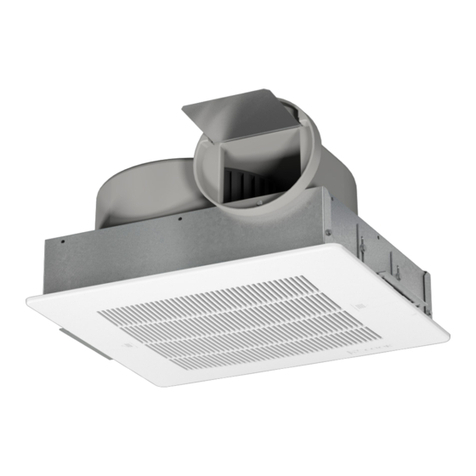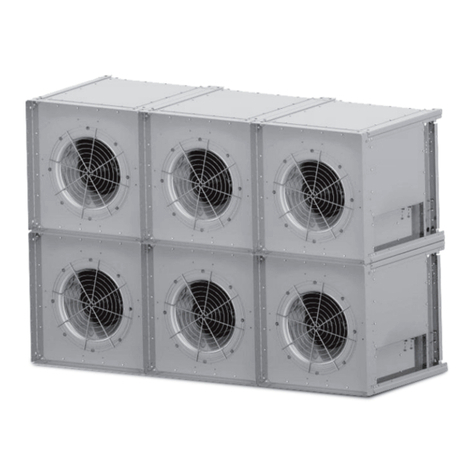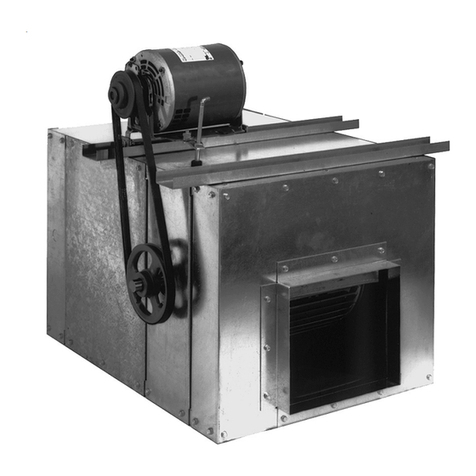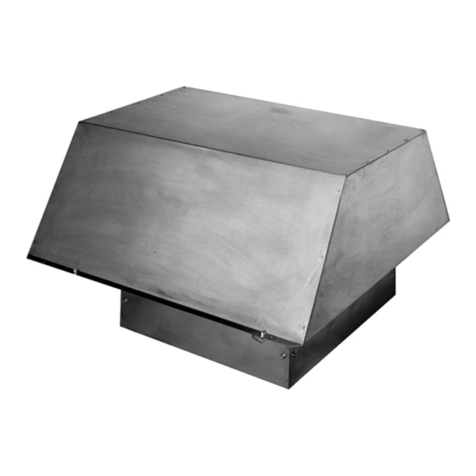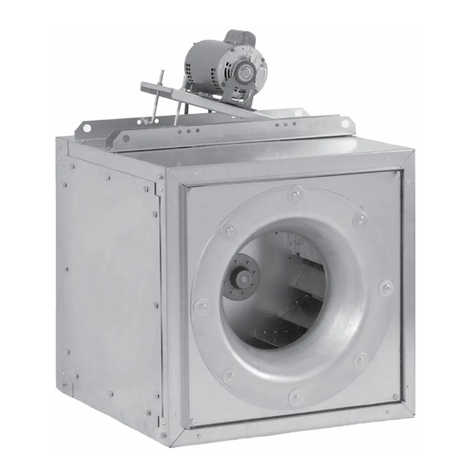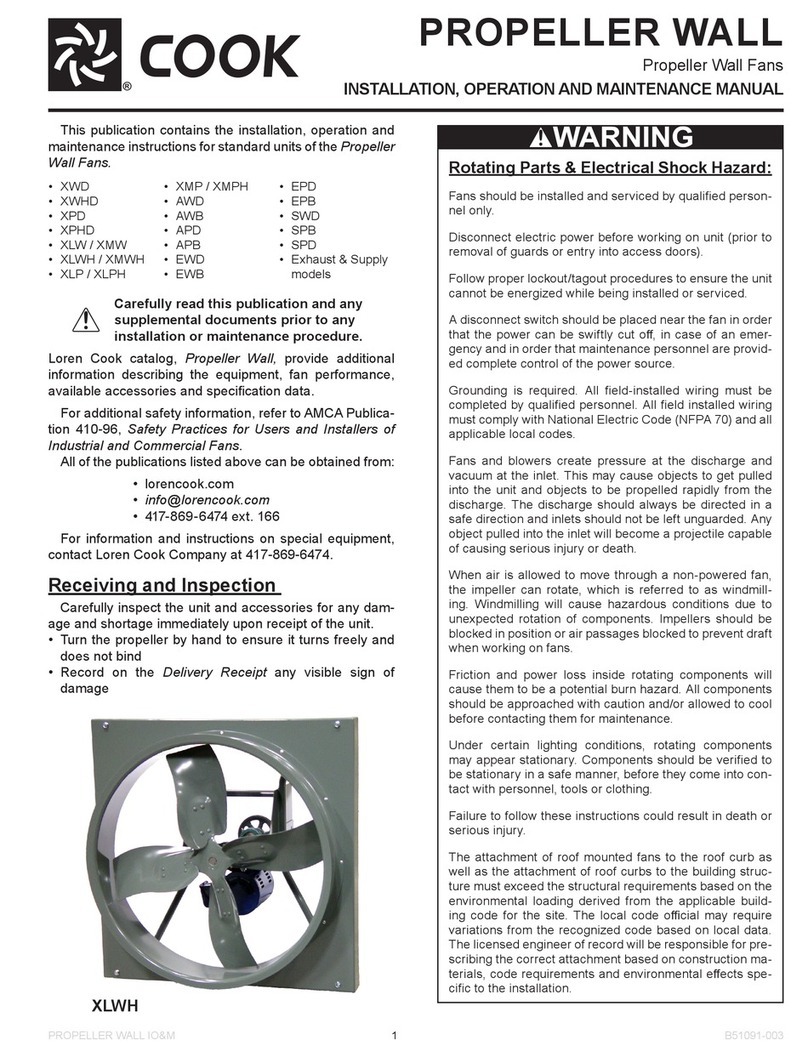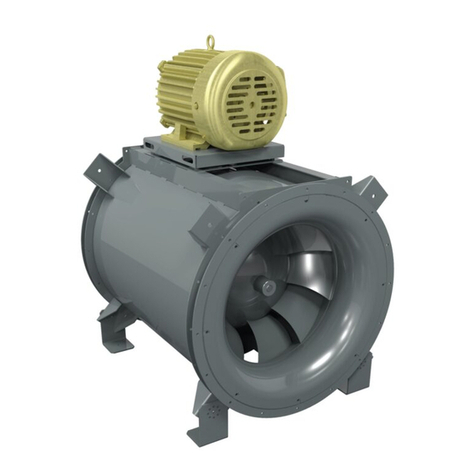
6TMX IO&M B51108-003
For motors with provisions for relubrication, follow inter-
vals of the table below.
Relubrication Intervals
Service
Conditions
Nema Frame Size
184T and Smaller 213T- 365T 404T and Larger
1800
RPM
and
Less
Over 1800
RPM
1800
RPM
and
Less
Over
1800
RPM
1800 RPM
and Less
Over
1800
RPM
Standard 3 yrs. 6 months 2 yrs. 6 months 1 yr. 3 months
Motors are provided with a polyurea mineral oil NGLI #2
grease. All additions to the motor bearings are to be with
a compatible grease such as Exxon Mobil Polyrex EM and
Chevron SRI.
The above intervals should be reduced to half for verti-
cal shaft installations.
Motor Services
Should the motor prove defective within a one-year pe-
riod, contact your local Loren Cook representative or your
nearest authorized electric motor service representative.
Changing Shaft Speed
All belt driven fans with motors up to and including 5HP
are equipped with variable pitch pulleys. To change the fan
speed, perform the following:
1. Loosen setscrew on driver (motor) pulley and remove
key, if equipped.
2. Turn the pulley rim to open or close the groove facing.
If the pulley has multiple grooves, all must be adjusted
to the same width.
3. After adjustment, inspect for proper belt tension.
Speed Reduction
Open the pulley in order that the belt
rides deeper in the groove (smaller pitch
diameter).
Speed Increase
Close the pulley in order that the belt
rides higher in the groove (larger pitch
diameter). Ensure that the RPM limits of
the fan and the horsepower limits of the
motor are maintained.
Pulley and Belt Replacement
1. Loosen and remove belts by adjusting motor mounting
plate.
2. Remove pulleys from their respective shafts.
3. Clean the motor and fan shafts.
4. Clean bores of pulleys and coat bores with heavy oil.
5. Remove grease, rust or burrs from pulleys and shafts.
6. Remove burrs from shaft by sanding.
7. Place fan pulley on fan shaft and motor pulley on motor
shaft. Damage to pulleys can occur when excessive
force is used in placing the pulleys on their respective
shafts.
8. Tighten in place.
9. Install belts on pulleys and align as described in Belt
and Pulley Installation (page 3.)
Bearing Replacement
The fan bearings are pillow block ball bearings.
1. Loosen and remove belts by adjusting motor mount-
ing plate.
• Bearings should be inspected as recommended in the
Lubrication Conditions Chart (page 6)
• Inspect variable inlet vanes (if supplied) for freedom of
operation and excessive wear. The vane position should
agree with the position of the control arm. As the vari-
able inlet vanes close, the entering air should spin in the
same direction as the wheel
• Inspect springs and rubber isolators for deterioration
and replace as needed
• Inspect for cleanliness. Clean exterior surfaces only.
Removing dust and grease on motor housing assures
proper motor cooling. Removing dirt from the wheel and
housing prevents imbalance and damage
Lubrication
Fan Bearings
TMX bearings are lubricated through a grease tting on
the exterior of the fan housing and should be lubricated by
the schedule, Lubrication Conditions Chart.
For best results, lubricate the bearing while the fan is in
operation. Pump grease in slowly until a slight bead forms
around the bearing seals. Excessive grease can burst
seals thus reducing bearing life.
Lubrication Conditions Chart
Fan
Class Fan Status Shaft Size Maximum Interval
(operation hrs)
TMX Normal Conditions
(clean, dry & smooth) <1-1/2” 2000
In the event the bearing cannot be seen, use no more
than three injections with a hand-operated grease gun.
Before lubricating, the grease nipple and immediate
vicinity should be thoroughly cleaned without the use of
high pressure equipment. The grease should be supplied
slowly as the bearing rotates until fresh grease slips past
the seal. Excessive pressure should be avoided to prevent
seal damage.
Exceptions to the greasing interval chart:
• Periodic Applications (any break of one week or
more): it is recommended that full lubrication be per-
formed prior to each break in operation
• Higher Temperature: it is recommended to halve the in-
tervals for every 30°F increase in operating temperature
above 120°F not to exceed 180°F.
• Vertical Shaft: it is recommended that the intervals
should be halved
Loren Cook Company uses petroleum lubricant in a lithi-
um base. Other types of grease should not be used unless
the bearings and lines have been ushed clean. If another
type of grease is used, it should be a lithium-based grease
conforming to NLGI grade 2 consistency.
A NLGI grade 2 grease is a light viscosity, low-torque,
rust-inhibiting lubricant that is water resistant. Its tempera-
ture range is from -30°F to +200°F.
Motor Bearings
Motors are provided with prelubricated bearings. Any lu-
brication instructions shown on the motor nameplate su-
persede instructions below.
Motor bearings without provisions for relubrication will
operate up to 10 years under normal conditions with no
maintenance.
Size
Maximum
RPM
Arr 9 Arr 4
90 3087 3087
120 2314 2314
135 2154 2154
150 1990 1990
165 1704 1943
180 1528 1528
202 1400 1400
225 1273 1273
245 1308 1308
270 1140 -
300 969 -
330 838 -








